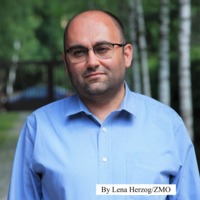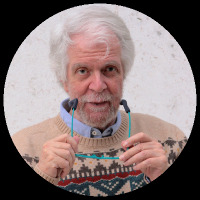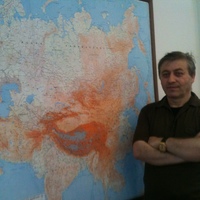
Gerardo Barbera
I am an Italian teacher in a public middle school (typically for students aged 11 to 14 years old) in Naples and an independent researcher in Iranian studies, specializing in southern Iran and Balochi dialects. As a trained field linguist, I have carried out fieldwork on endangered and underdocumented languages spoken inland from the Strait of Hormuz, focusing on the Bashkardi language group and related southern Iranian dialects.
Originally from Sicily, I moved to Naples to pursue Classics at L’Orientale University, where I earned both my BA/MA (2000) and a PhD in Iranian philology and dialectology (Turkey, Iran, Central Asia program, 2005). From 2000 to 2007, I worked as a research assistant at the Department of Asian Studies, L'Orientale University, contributing to projects on Balochi etymology and Achaemenid philology, with a focus on bibliographic research and analysis in the latter. From 2007 to 2009, I was a postdoctoral fellow in the Department of Linguistics at SOAS, University of London.
Although during an extended period—primarily due to teaching commitments—my direct involvement in scientific research was reduced to a minimum, I remained committed to staying current in the field, maintaining a private library that ranks among the most extensive collections on Iranian dialectology outside Iran, both in comparison to university libraries and private holdings. More recently, I have fully resumed and sharpened my focus on fieldwork-based linguistic research, with current projects including a comprehensive glossary of the Minab dialect (Hormozgan Province) and a comparative study of Bashkardi and Garmsiri body part terminology.
My work is dedicated to the documentation and preservation of these critically endangered and largely undocumented linguistic varieties, for which almost no published material exists. This reflects a broader and long-standing gap in scholarship concerning the languages and dialects of southern Iran and the Persian Gulf region.
I’ve begun sharing many of these on Academia.edu to make them more accessible—especially for readers in Iran, where the work speaks directly to local cultures. Increasingly, I find it unacceptable that this research remains locked inside prohibitively expensive, often heavily copyrighted books published by grandiose academic presses—books so frequently pursued for their prestige, yet priced at levels that make them deeply disruptive to purchase.
In today’s world, that kind of gatekeeping—restricting access to knowledge through prohibitively expensive and inaccessible purchase models—feels not just out of step, but ethically indefensible.
Originally from Sicily, I moved to Naples to pursue Classics at L’Orientale University, where I earned both my BA/MA (2000) and a PhD in Iranian philology and dialectology (Turkey, Iran, Central Asia program, 2005). From 2000 to 2007, I worked as a research assistant at the Department of Asian Studies, L'Orientale University, contributing to projects on Balochi etymology and Achaemenid philology, with a focus on bibliographic research and analysis in the latter. From 2007 to 2009, I was a postdoctoral fellow in the Department of Linguistics at SOAS, University of London.
Although during an extended period—primarily due to teaching commitments—my direct involvement in scientific research was reduced to a minimum, I remained committed to staying current in the field, maintaining a private library that ranks among the most extensive collections on Iranian dialectology outside Iran, both in comparison to university libraries and private holdings. More recently, I have fully resumed and sharpened my focus on fieldwork-based linguistic research, with current projects including a comprehensive glossary of the Minab dialect (Hormozgan Province) and a comparative study of Bashkardi and Garmsiri body part terminology.
My work is dedicated to the documentation and preservation of these critically endangered and largely undocumented linguistic varieties, for which almost no published material exists. This reflects a broader and long-standing gap in scholarship concerning the languages and dialects of southern Iran and the Persian Gulf region.
I’ve begun sharing many of these on Academia.edu to make them more accessible—especially for readers in Iran, where the work speaks directly to local cultures. Increasingly, I find it unacceptable that this research remains locked inside prohibitively expensive, often heavily copyrighted books published by grandiose academic presses—books so frequently pursued for their prestige, yet priced at levels that make them deeply disruptive to purchase.
In today’s world, that kind of gatekeeping—restricting access to knowledge through prohibitively expensive and inaccessible purchase models—feels not just out of step, but ethically indefensible.
less
Related Authors
Armando Salvatore
McGill University
Katherine Butler Schofield
King's College London
Sébastien Lacrampe
University of Melbourne
Zeynep Tuba Sungur
Ankara Sosyal Bilimler Üniversitesi / Social Sciences University of Ankara
M. Talha ÇİÇEK
Istanbul Medeniyet University
Armando Marques-Guedes
UNL - New University of Lisbon
Michael Shenkar
The Hebrew University of Jerusalem
Alexandre Caeiro
Hamad Bin Khalifa University
Rudolph (Rudi) Matthee
University of Delaware
Süer Eker
Baskent University










Uploads
Papers by Gerardo Barbera
Field Texts from Southern Iran by Gerardo Barbera
(This research was carried out as part of a project co-funded by the Italian Ministry of Education, University and Research [Ministero dell’Istruzione, dell’Università e della Ricerca] and the Iran Heritage Foundation, London.)
(This research was carried out as part of a project co-funded by the Italian Ministry of Education, University and Research [Ministero dell’Istruzione, dell’Università e della Ricerca] and the Iran Heritage Foundation, London.)
This article explores the largely undocumented cultural, linguistic, and historical landscape of Bashkard (officially Bashāgerd), a remote mountainous region in western Makran, Iran. Despite increasing interest in its dialects, broader ethnographic and historical studies remain limited and outdated. Drawing on both early sources—such as the fieldwork of Alfons Gabriel and Ilya Gershevitch—and recent research, the article compiles and updates scattered data on Bashkard’s material culture, oral traditions, and unique social hierarchy, which historically included freemen, slaves, and ruling clans. It also revisits classical and medieval identifications of the region and proposes a new etymology linking the name "Bashkard" to Old Iranian Pāθragadǎ- (Pasargadae), adding a fresh dimension to the understanding of its historical identity.
The data reveal complex interaction patterns of inherited Iranian roots, local innovations, and cross-dialectal borrowings. Particular emphasis is placed on morphological productivity, semantic shifts, and areal convergence phenomena. This lexical field highlights both the depth of inherited structures and the dynamism of regional linguistic creativity in Iranian dialectology.
In Balochi, the picture is more nuanced. Both gwask, matching the Garmsiri forms, and gwašk, characterized by the relatively rare °šk cluster, are attested—the latter confined to the Saravāni dialect and pointing towards a localized retention of older lexical strata. By contrast, forms such as gwačč in certain dialects and wačč in others, which have expanded their semantic scope to include meanings like ‘child,’ ‘lamb,’ and ‘young hen,’ appear more widespread and are plausibly explained through contact with Indo-Aryan languages. Nevertheless, some uncertainty remains regarding their ultimate origins, and it is conceivable that gwačč and wačč may also be indirectly connected to gwask through phonological simplification and semantic extension—or possibly directly, through internal phonological developments within Balochi—rather than exclusively through borrowing.
Importantly, any comparison between the Balochi and Garmsiri forms must consider the intricate and layered nature of phonological evolution in these dialects. In particular, Balochi wačč—if not a borrowing—could represent a simplified or reduced form of gwačč, as Proto-Iranian *u̯- consistently yields gw- before a and ā, but never w- without intermediary stages.
By tracing a single lexical item, the study offers broader insights into phonological change, lexical dynamics, and socio-linguistic influences within Southwestern Iranian dialects. Ultimately, it refines our understanding of intra-Iranian relationships, highlights contact-induced change, and demonstrates the value of micro-dialectal analysis in historical reconstruction.
*** While the Festschrift in honour of Professor Adriano V. Rossi was being prepared, I struggled to find a theme that could adequately reflect my gratitude, admiration, and deep personal regard. I drafted several articles, ultimately completing one on the Mināb dialect, which I later withdrew and published elsewhere. The reason was simple: its focus did not lie on the lexicon—an area of central importance in Professor Rossi’s research and in much of the work carried out by his students. This brief note is offered instead as a modest supplement to the two-volume celebratory collection presented in Naples in 2019.